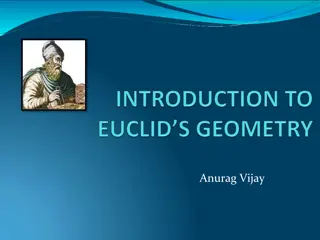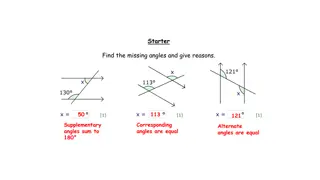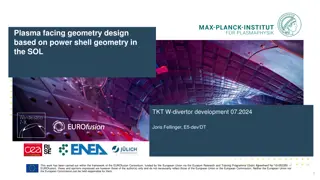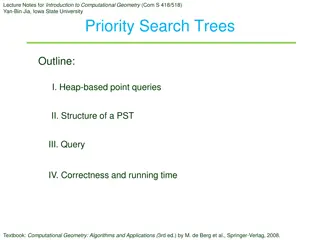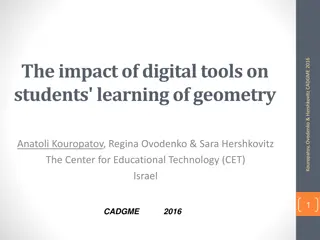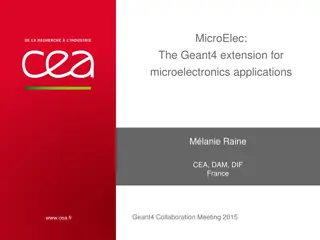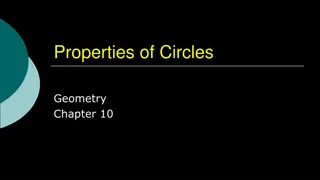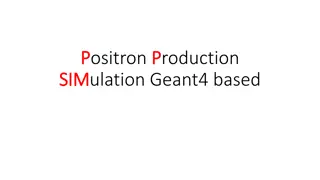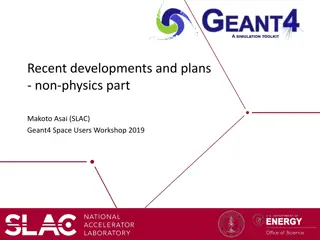Insights from Geant4 Development Team on ATLAS Geometry Investigations
Investigating the ATLAS geometry using Geant4, the team from National Research Tomsk State University presented findings at the 23rd Geant4 Collaboration Meeting. They focused on solid methods, CPU consumption, and optimizing geometry descriptions to enhance simulation performance. Specifics of the ATLAS geometry, side effects of GeoModel features, and analysis of the ATLAS GDML dump were discussed, emphasizing the importance of accurate detector simulation in complex environments.
Download Presentation

Please find below an Image/Link to download the presentation.
The content on the website is provided AS IS for your information and personal use only. It may not be sold, licensed, or shared on other websites without obtaining consent from the author.If you encounter any issues during the download, it is possible that the publisher has removed the file from their server.
You are allowed to download the files provided on this website for personal or commercial use, subject to the condition that they are used lawfully. All files are the property of their respective owners.
The content on the website is provided AS IS for your information and personal use only. It may not be sold, licensed, or shared on other websites without obtaining consent from the author.
E N D
Presentation Transcript
National Research Tomsk State University Investigations in the ATLAS Investigations in the ATLAS geometry geometry Evgueni Tcherniaev Geant4 development team
Outline Introduction Side effect of some GeoModel features Statistics of Geant4 solid methods Usage of Boolean solids Usage of G4Polycone solids CPU consumption by Solids & Navigator Miscellaneous Summary 28 August 2018 23rd Geant4 Collaboration Meeting, Lund, Sweden 1
Introduction 28 August 2018 23rd Geant4 Collaboration Meeting, Lund, Sweden 2
Analysis of the ATLAS geometry The purpose of the analysis was to gather quantitative information on usage of Geant4 solids in the simulation of very complex detector. Gathered information was used: To enhance of Geant4/Geometry code by taking into account the specifics of the shapes used in the detector description To spot places, where the ATLAS geometry description can be optimized It also has improved the ability to predict the impact on the performance of various modifications 28 August 2018 23rd Geant4 Collaboration Meeting, Lund, Sweden 3
Specifics of the ATLAS geometry ATLAS geometry description is very complex It contains several millions of physical volumes ATLAS geometry description is very detailed, for example: 7756 G4Box solids have volume < 1 cm3, of those 472 have volume < 1 mm3 798 G4Tubs solids have volume < 1 cm3, of those 123 have volume < 1 mm3 There is a custom solid used for navigation inside EMEC (Electromagnetic End-cup Calorimeter). Simulation inside EMEC takes >35% of CPU. ATLAS geometry description is based on GeoModel: GeoModel is a library of C++ classes that can be used to describe detector geometries GeoModel often means also a structure of geometrical primitives that, in principle, can be transferred into the structures of various simulation packages To transfer the GeoModel structure into the Geant4 structure a tool Geo2G4 is used 28 August 2018 23rd Geant4 Collaboration Meeting, Lund, Sweden 4
Side effect of some GeoModel features o Issue with TRT mother volume o Fake overlaps 28 August 2018 23rd Geant4 Collaboration Meeting, Lund, Sweden 5
Analysis of ATLAS GDML dump Geant4 has a number of useful tests which work with GDML files: overlap check, Geantino test, real simulation test When running those tests with the GDML dump, provided by the ATLAS simulation group, we have faced a couple of unexpected issues: Original GDML dump did not loaded: PANIC! - Overlapping daughter with mother volume. Daughter physical volume TRT is entirely outside mother logical volume TRT::TRT !! After a manual fix of the GDML file, the overlap check has discovered several rather big, suspicious overlaps 28 August 2018 23rd Geant4 Collaboration Meeting, Lund, Sweden 6
Issue with TRT mother volume in GDML The mother volume of TRT (Transition Radiation Tracker) is described as a union of its daughter volumes In the original GDML file both end cups were placed on the same side relative to the central barrel (problems with rendering are caused by that) A bit of history: the issue with TRT in the GDML dump has been discovered in November 2014. It was considered as a bug in the GDML writer. Indeed, a bug in the GDML writer has been found and fixed. However... The same issue has been re-discovered three years later, in October 2017 the bug fixed in 2014 was not the reason of the issue with TRT Finally, during ATLAS Hackathon in February 2018 the issue with TRT has been understood and fixed 28 August 2018 23rd Geant4 Collaboration Meeting, Lund, Sweden 7
Use of G4DisplacedSolid objects The reason of the issue with TRT was a construction of a G4DisplacedSolid object from another G4DisplacedSolid object. Although G4DisplacedSolid is meant to be used as an internal class for Boolean solids, it has all methods required for the navigation and is used in ATLAS/GeoModel as an ordinary solid. To fix the issue, the constructors of G4DisplacedSolid have been enhanced to handle the case of nested displaced objects. The modification has also improved the performance of Boolean operations in such a case. 28 August 2018 23rd Geant4 Collaboration Meeting, Lund, Sweden 8
Overlap check The existence of overlaps in the detector geometry description means that there are some issues in the geometry definition that may lead to incorrect result of the simulation Geant4 tracking algorithms are quite sensitive to overlaps, which can be the cause of various issues during tracking, for example skipping of material (and eventually sensitive material) Below is the result of overlap check in the GDML dumps: Inner Detector 1983 overlaps Calorimeters 172 overlaps Muon System 332 overlaps 28 August 2018 23rd Geant4 Collaboration Meeting, Lund, Sweden 9
Propagation of Boolean subtraction to daughter volumes. Fake overlaps A number of fake overlaps (20-40 cm) have been observed in the end cups of the Tile calorimeter The fake overlaps have appeared as a result of automatic propagation by GeoModel of Boolean subtraction, applied to a sector of the end cup (see the image), to its daughter volumes If the result of a Boolean operation (subtraction or intersection) is a null object, the Geant4 overlap check may report an overlap. In such a case the warning message on overlap will be preceded by a warning message on a failure to pick up a random point on the surface of the object: All attempts to generate a point on the surface have failed! The solid created may be an invalid Boolean construct! Null objects do not create problems for tracking, however they consume execution time 28 August 2018 23rd Geant4 Collaboration Meeting, Lund, Sweden 10
Statistics of Geant4 solid methods 28 August 2018 23rd Geant4 Collaboration Meeting, Lund, Sweden 11
Distribution of calls by Solids and Methods Number of calls for simulation of 10 ttbar events, Geant4 10.01.patch03.atlas05 Inside x 106 Normal x 106 SafetyToIn x 106 SafetyToOut x 106 DistanceToIn x 106 DistanceToOut x 106 TOTAL x 106 421 1 19 5 9 4 459 G4Box G4Trap G4Polycone G4Tubs G4Trd G4Extruded G4Union G4Subtraction G4Displaced 978 1 111 42 38 23 1193 336 1 21 120 9 41 528 172 9 168 124 66 46 585 34 16 14 6 9 79 3 3 6 1287 3 23 6 14 22 1355 38 13 1 2 54 1385 1 34 4 19 5 1448 It took quite a bit of time to understand why there is so many calls to Inside() for G4Union, G4DisplacedSolid, G4Box and G4Trap The reason was just in three identical Boolean solids that had 42 components 28 August 2018 23rd Geant4 Collaboration Meeting, Lund, Sweden 12
Usage of Boolean solids o Bad practices in usage of Boolean solids o CPU consumption by TMT 28 August 2018 23rd Geant4 Collaboration Meeting, Lund, Sweden 13
Booleans solids in ATLAS geometry Boolean solids, except G4MultiUnion, do not have internal optimization. The time required for calculations in Boolean solids scales at best with the number of components, often worse than this because of rather complicated logic of the calculations. Below is a list of Boolean volumes in different parts of the Atlas detector: Inner Detector 465 Boolean volumes 3 volumes are composed of 42 components others are composed of 2 11 components Tile Calorimeter 15863 Boolean volumes Almost all Boolean solids can be replaced with Extruded Solids Muon System 2869 Boolean volumes >170 volumes have 30 - 82 components 28 August 2018 23rd Geant4 Collaboration Meeting, Lund, Sweden 14
Typical bad practices in using Boolean solids Below is a list of typical usage of Boolean solids that can degrade the performance: 1) Usage of Boolean subtraction to define holes A better way to define holes is to define them as daughter volumes 2) Describing a mother volume as a union of its daughter volumes A better way to group volumes is to use G4AssemblyVolume 3) Usage of a Boolean solid with complex shape for very low level volume A better way is to split the solid into simple parts and, if required, group the parts using G4AssemblyVolume A solid defined for Thermal Management Tile (TMT) is an extreme example of the case 3) the TMT solid has been constructed as a union of 6 G4Box solids and 36 G4Trap solids 28 August 2018 23rd Geant4 Collaboration Meeting, Lund, Sweden 15
ATLAS Pixel detector 112 staves No. of staves: B-layer 22, Layer 1 38, Layer 2 52 28 August 2018 23rd Geant4 Collaboration Meeting, Lund, Sweden 16
Pixel Stave Profile. Thermal Management Tile 28 August 2018 23rd Geant4 Collaboration Meeting, Lund, Sweden 17
Redefinition of TMT: old vs new Profile comparison of two geometries: aibuild027.cern.ch, SLC6, 1.20 GHz FullG4 simulation, Geant4 10.01.patch03.atlas07, 10 events Average time per event: 238.0 s vs 232.9 s (~2% less) Inside x 106 72.9 | 37.6 124.2 | 58.0_ 32.8 | 30.9 150.4 | 146.9 3.9 | 3.6 317.0 | 314.8 1168.7 | 33.9__ 62.9 | 42.4 1171.4 | 73.2__ 3104 | 741_ Normal x 106 1.3 | 1.2 1.0 | 1.0 0.5 | 0.5 9.1 | 8.9 SafetyToIn x 106 21.2 | 18.6 110.3 | 107.3 18.5 | 17.7 165.9 | 162.4 4.0 | 3.5 21.6 | 21.3 23.0 | 16.6 17.8 | 15.1 36.4 | 28.5 419 | 391 SafetyToOut x 106 5.1 | 4.9 43.4 | 44.2 15.4 | 15.0 122.5 | 121.0 0.5 | 0.5 115.7 | 114.8 6.4 | 4.7 2.8 | 2.2 4.7 | 4.8 316 | 312 DistToIn x 106 9.8 | 8.7 38.0 | 34.2 7.3 | 7.0 65.2 | 64.4 0.6 | 0.5 9.0 | 8.9 13.8 | 8.7_ 3.4 | 2.9 19.9 | 14.1 167 | 149 DistToOut x 106 4.6 | 4.2 23.6 | 23.0 10.3 | 10.0 45.3 | 44.7 0.1 | 0.1 39.0 | 38.8 22.7 | 3.2_ 1.2 | 0.9 5.3 | 4.0 152 | 128 G4Box G4Trap G4Trd G4Tubs G4Extruded G4Polycone G4Union G4Subtraction G4Displaced Total 1.6 | 1.6 3.4 | 1.8 0.4 | 0.3 1.4 | 1.3 19 | 17 4177 vs 1738 (G4Tubs 548, G4Polycone 500) 28 August 2018 23rd Geant4 Collaboration Meeting, Lund, Sweden 18
Redefinition of TMT. Summary Redefinition of TMT has reduced the number of calls to Inside()by several times: more than 4 times in comparison Geant4 10.01.patch03.atlas07 (741 x106 instead of 3104 x106) more than 6 times in comparison with Geant4 10.01.patch03.atlas02 (741 x106 instead of 4700 x106) Combination of Geant4 10.01.patch03.atlas07 & new TMT may give 5% improvement in the performance of FullATLASG4 simulation After redefinition of TMT, 60% of calls are to the methods of G4Tubs and G4Polycone (31.5% + 28.8%) 28 August 2018 23rd Geant4 Collaboration Meeting, Lund, Sweden 19
Usage of G4Polycone solids o EMEC Wheels o Beam pipe o World and Muon system volumes 28 August 2018 23rd Geant4 Collaboration Meeting, Lund, Sweden 20
General statistics After redefinition of TMT the distribution of calls to Geant4 Solids is as follows: ~30% to the methods of G4Polycone ~30% to the methods of G4Tubs ~40% to the methods of other G4 solids So, it is clear that revision of G4Tubs and, especially, G4Polycone has sense There are 135 different G4Polycone solids, below is the summary of their usage EMEC Wheels Muon System Beam Pipe N. of Z-sections N. of solids % of calls % of time N. of Z-sections N. of solids % of calls % of time Nz = 2 25 solids 32.6% 10.1% Nz = 12 4 solids 2.0% 6.7% Nz = 3 17 solids 54.4% 33.7% Nz = 17 1 solid 0.1% 0.5% Nz = 4 31 solids 2.1% 1.9% Nz = 18 3 solid 1.7% 8.7% Nz = 5 5 solids 0.4% 0.5% Nz = 24 1 solid 0.3% 2.4% Nz = 6 38 solids 2.3% 3.6% Nz = 26 1 solid 0.7% 5.3% Nz = 7 4 solids 0.1% 0.2% Nz = 32 1 solid 0.4% 3.8% Nz = 10 1 solid 0.3% 0.7% Nz = 34 2 solids 0.7% 7.0% Nz = 38 1 solid 1.3% 14.9% 28 August 2018 23rd Geant4 Collaboration Meeting, Lund, Sweden 21
Potential optimization There are three places where relatively simple modifications in the geometry can improve the performance: EMEC Inner and Outer Wheels (estimated percentage of time is ~40% or ~4% of CPU) Beam Pipe mother volume (estimated percentage of time is ~15% or ~1.5% of CPU) World volume + Muon System mother volume (estimated percentage of time is ~9% or ~0.9% of CPU) Remark: (% of CPU time) ~= (% of time spent in G4Polycone) / 10 28 August 2018 23rd Geant4 Collaboration Meeting, Lund, Sweden 22
EMEC Inner Wheel All solids below have exactly the same parameters: G4Polycone : Nz=2 Sphi=0o Dphi=360o (can be replaced with G4Cons) z, rmin, rmax = 0, 302.3, 610.4 z, rmin, rmax = 514, 344.3, 695.3 FullG4 simulation, 10 events, 500 x106 calls to G4Polycone methods Inside x 106 Normal x 106 SafetyToIn x 106 SafetyToOut x 106 DistToIn x 106 DistToOut x 106 LAr::EMEC::Neg::InnerWheel ::Absorber-BoundingPolycone ::Electrode-BoundingPolycone ::Glue-BoundingPolycone ::Lead-BoundingPolycone Total LAr::EMEC::Pos::InnerWheel ::Absorber-BoundingPolycone ::Electrode-BoundingPolycone ::Glue-BoundingPolycone ::Lead-BoundingPolycone Total 4.65 19.69 14.65 17.35 18.68 0.28 5.31 4.93 2.32 3.42 7.05 0.06 0.11 2.59 1.36 2.57 1.93 106.5 x106 ( 21% ) 0.17 2.20 9.33 6.95 8.26 8.72 2.47 2.28 1.08 1.62 3.18 0.04 0.06 1.25 0.66 1.24 0.91 49.5 x106 ( 10% ) 28 August 2018 23rd Geant4 Collaboration Meeting, Lund, Sweden 23
EMEC Outer Wheel All solids below have exactly the same parameters: G4Polycone : Nz=3 Sphi=0o Dphi=360o (a union of two hollow cones) z, rmin, rmax = 0, 613.4, 1999.9 z, rmin, rmax = 63.2, 623.8, 2034 z, rmin, rmax = 514.0, 698.3, 2034 Inside x 106 Normal x 106 SafetyToIn x 106 SafetyToOut x 106 DistToIn x 106 DistToOut x 106 LAr::EMEC::Neg::OuterWheel ::Absorber-BoundingPolycone ::Electrode-BoundingPolycone ::Glue-BoundingPolycone ::Lead-BoundingPolycone Total LAr::EMEC::Pos::OuterWheel ::Absorber-BoundingPolycone ::Electrode-BoundingPolycone ::Glue-BoundingPolycone ::Lead-BoundingPolycone Total 7.95 35.26 26.12 31.87 31.15 0.27 8.99 8.67 4.14 6.24 10.49 0.04 0.10 4.88 2.57 4.84 3.33 186 x106 ( 37% ) 0.15 2.12 9.65 7.12 8.94 8.20 2.29 2.24 1.08 1.72 2.42 0.01 0.03 1.42 0.74 1.41 0.91 50 x106 (10%) 28 August 2018 23rd Geant4 Collaboration Meeting, Lund, Sweden 24
EMEC Wheels. Summary EMEC Inner and Outer Wheels take 78% of calls to G4Polycone and approximately 40% of the time spent in G4Polycone The G4Polycone solids used in the EMEC Wheels are auxiliary objects, they are not used in any logical or physical volumes Suggestions: Replace the G4Polycone solids in EMEC Inner Wheel (Nz=2) with G4Cons Consider replacement of the G4Polycone solids in EMEC Outer Wheel (Nz=3) with simpler shapes 28 August 2018 23rd Geant4 Collaboration Meeting, Lund, Sweden 25
Beam pipe The BeamPipe mother volume is a Boolean union of its daughter volumes. It consists of three parts: one G4Tubs solid (BeamPipeCentral) and two G4Polycone solids (BeamPipeFrw) BeamPipeFrw & BeamPipeCentral & BeamPipeFrw BeamPipeFrw has 38 Z-sections (37 tubes), takes 1.3% of calls to G4Polycone and approximately 15% of the time spent in G4Polycone Suggestions: Eliminate the BeamPipe mother volume - BeamPipeCentral and BeamPipeFrw can be included directly to the World volume In addition BeamPipeFrw can be simplified 28 August 2018 23rd Geant4 Collaboration Meeting, Lund, Sweden 26
World volume and Muon System mother volume The structure of the top volumes: Atlas > MUONQ02 > MuonSys > CALO > IDET > BeamPipe World volume (Atlas) has 18 Z-sections (17 cylinders) and takes 0.39% of calls to G4Polycone MUONQ02 has 34 Z-sections (33 tubes) and takes 0.36% of calls to G4Polycone MuonSys has very similar shape to the shape of MUONQ02 (34 Z-sections) and takes 0.32% of calls to G4Polycone Atlas + MUONQ02 + MuonSys take approximately 9% of the time spent in G4Polycone Suggestions: Simplify the World volume Revise (simplify or, possibly, entirely eliminate) the bounding volume for Muon system 28 August 2018 23rd Geant4 Collaboration Meeting, Lund, Sweden 27
CPU consumption by Geometry & Navigator 28 August 2018 23rd Geant4 Collaboration Meeting, Lund, Sweden 28
Profile of Geantino test Comparison of the CPU time spent by the Geantino test and the CPU time of real simulation has allowed to estimate CPU consumption by the Geometry & Navigation code. Below is distribution of calls by Solids and Methods for the Geatino test run on the GDML dump, where 112 physical volumes with TMT have been removed MacBook Pro, Intel Core i5, 2.7 GHz 100k events, No. of steps: 159.739.590, CPU time: 186 s Inside x 106 Normal x 106 SafetyToIn x 106 SafetyToOut x 106 DistToIn x 106 DistToOut x 106 G4Box G4Trap G4Trd G4Tubs G4Extruded G4Polycone G4Union G4Subtraction G4Displaced Total 236 30 264 640 17 28 164 656 865 2900 4 38 28 54 84 2 5 23 15 54 303 15 25 62 44 1 13 19 26 8 213 34 25 50 76 2 5 21 13 52 278 21 25 65 41 1 6 21 25 15 220 2 0.6 0.6 0.3 7 6 4 25 All 1039 (G4Tubs 246, G4Polycone 29) 28 August 2018 23rd Geant4 Collaboration Meeting, Lund, Sweden 29
Profile of real simulation aibuild027.cern.ch, SLC6, 1.20 GHz Simulation of 10 ttbar events, Geant4 10.01.patch03.atlas07 (currently under verification) No. of steps: unknown, CPU time: ~250 s / event (>35% in EMEC) Inside x 106 Normal x 106 SafetyToIn x 106 SafetyToOut x 106 DistToIn x 106 DistToOut x 106 G4Box G4Trap G4Trd G4Tubs G4Extruded G4Polycone G4Union G4Subtraction G4Displaced Total 38 101 29 146 1 1 19 111 16 168 5 9 4 42 14 124 38 6 66 23 9 46 9 2 3 332 1162 35 1149 2994 1 3 21 23 13 34 408 120 9 41 22 6 1 4 14 2 19 163 1 5 16 316 150 All 1053 (G4Tubs 413, G4Polycone 192) 28 August 2018 23rd Geant4 Collaboration Meeting, Lund, Sweden 30
CPU consumption by Solids & Navigator Quantitative characteristics of two tests are very similar: Number of calls to Inside(): 2994 vs 2900 (x106) Number of calls to other functions: 1053 vs 1039 (x106) So, the execution time of the Geantino test can be used as a good estimation of the CPU time consumed by Geant4 Solids & Navigator in real simulation: Conversion factor between the platforms: 2.70 GHz / 1.20 GHz = 2.25 Estimation of the execution time of the Geantino test on aibuild027.cern.ch: 186 * 2.25 >= 420 s CPU time that would be consumed by Geant4 Solids & Navigator in one event: 420 / 10 >= 42 s Estimated percentage: 42 / 250 >= 17% Estimated percentage if to exclude the time spent in EMEC (>35%): 42 / (250 * 0.65) >= 26% Taking into account that in real simulation there were more calls to G4Tubs and G4Polycone, 413 vs 246 (x106) and 192 vs 29 (x106) respectively, it will be correct to say that the percentage of CPU time consumed by Geant4 Solids & Navigator varies between 20% and 30% 28 August 2018 23rd Geant4 Collaboration Meeting, Lund, Sweden 31
Miscellaneous o Resolution of G4Exception messages o Enhancement of G4AffineTransform o Optimizations in navigation code 28 August 2018 23rd Geant4 Collaboration Meeting, Lund, Sweden 32
Resolution of G4Exception warnings There were 72 G4Exeption messages during simulation of 500 events with current production version Geant4 10.01.patch03.atlas02: 63 messages - Track stuck or not moving. 8 messages - Proposed step is zero; hstep = 0 ! 1 message - Expected normal-global-frame to be valid, i.e. a unit vector! All G4Exeption messages have disappeared in Geant4 10.01.patch03.atlas07 which at present time is under verification The disappearance of Track stuck or not moving is explained by the revision of G4Trd (code taken from Gean4 10.04) The disappearance of Proposed step is zero is explained by the bug fix in the calculation of the normal at the endpoint of current step in G4Navigator::GetLocalExitNormal() (code taken from Gean4 10.04.p02) It looks that the message on invalid normal was due to calculation errors. It has disappeared after last modifications in G4DisplacedSolid (Gean4 10.04.p02) 28 August 2018 23rd Geant4 Collaboration Meeting, Lund, Sweden 33
Enhancement of G4AffineTransform (1) G4AffineTransform is a class that is used to define the position of solids and to make transformation of points and vectors It is implemented as a 4x3 transformation matrix a 3x3 rotation matrix and a 3-vector shift All methods are inlined The methods that are used at navigation: Inverse() it returns the inverse transformation matrix Invert() it inverts the transformation matrix InvertProduct(t1,t2) it calculates t1*(t2-1) TransformPoint(p) it transforms a point TransformAxis(v) it transforms a vector 28 August 2018 23rd Geant4 Collaboration Meeting, Lund, Sweden 34
Enhancement of G4AffineTransform (2) G4AffineTransform::InvertProduct(t1,t2) has been optimized: now it does 36 multiplications instead of 45 as before A specialization for the case where t2 is a pure translation has been added. In such a case the computation of the product is very light: 3 subtractions, 12 assignments, no multiplications Four new methods have been added: InverseTransformPoint(p) it makes inverse transformation of a point InverseTransformAxis(v) it makes inverse transformation of a vector InverseNetRotation() it returns inverse rotation matrix InverseNetTranslation() it returns the shift vector of the inverse transformation 28 August 2018 23rd Geant4 Collaboration Meeting, Lund, Sweden 35
Optimizations in the navigation code Inverse transformation of points and vectors does not require addition computations in comparison with direct transformation: G4ThreeVector G4AffineTransform::TransformPoint(const G4ThreeVector& vec) const { G4double vecx = vec.x(), vecy = vec.y(), vecz = vec.z(); return G4ThreeVector( vecx*rxx + vecy*ryx + vecz*rzx + tx, vecx*rxy + vecy*ryy + vecz*rzy + ty, vecx*rxz + vecy*ryz + vecz*rzz + tz ); } G4ThreeVector G4AffineTransform::InverseTransformPoint(const G4ThreeVector& vec) const { G4double vecx = vec.x() - tx, vecy = vec.y() - ty, vecz = vec.z() - tz; return G4ThreeVector( vecx*rxx + vecy*rxy + vecz*rxz, vecx*ryx + vecy*ryy + vecz*ryz, vecx*rzx + vecy*rzy + vecz*rzz ); } New methods in G4AffineTransform allowed to eliminate Calculation/Instantiation of the inverse transformation in several navigation classes, for example: G4ThreeVector md = Td.Inverse().TransformPoint(mp); has been replaced with: G4ThreeVector md = Td.InverseTransformPoint(mp); 28 August 2018 23rd Geant4 Collaboration Meeting, Lund, Sweden 36
Summary 28 August 2018 23rd Geant4 Collaboration Meeting, Lund, Sweden 37
A detailed quantitative statistics on the use of Geant4 in ATLAS has been gathered. Jira tickets dedicated to specific findings can been found at the Epic collection ATLASSIM-3678 Improve the description of ATLAS in Geant4. In particular: ATLASSIM-3556Overlaps detected in MC16 geometry when running in standalone Geant4 ATLASSIM-3557 Optimizing Boolean solid use in ATLAS G4 geometry ATLASSIM-3680 Revision of TMT ATLASSIM-3778 Optimizing G4Polycone usage in ATLAS G4 geometry ATLASSIM-3761 Performance comparison of four geant4 patches A number of improvements have been done in Geant4, namely in G4Box, G4DisplacedSolid, G4UnionSolid, G4AffineTransform and navigation code (10.01.patch03.atlas07). The improvements will be included in Geant4 10.05 The issue with the description of the TRT mother volume in GDML has been fixed The G4Exception warnings observed during simulation of 500 events have disappeared The combination of Geant4 10.01.patch03.atlas07 & optimization of TMT has shown 5% speed-upin the performance for FullATLASG4 simulation and 11% speed-up for ATLFASTII Further improvement of the performance can be achieved by optimizing G4Polycone usage in the ATLAS geometry and revising G4Polycone code in Geant4 28 August 2018 23rd Geant4 Collaboration Meeting, Lund, Sweden 38
Thank you! 28 August 2018 23rd Geant4 Collaboration Meeting, Lund, Sweden 39
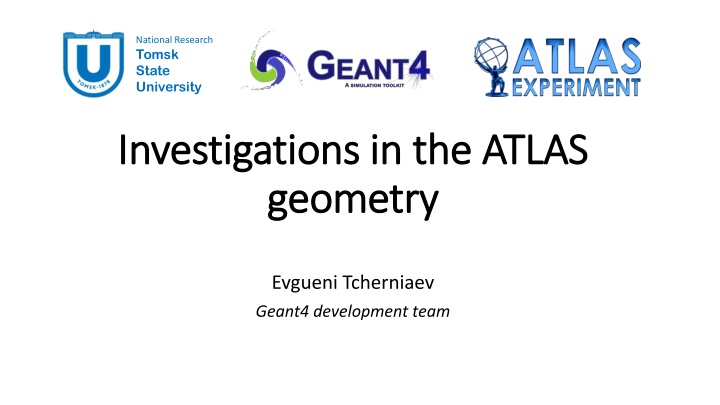

![[PDF⚡READ❤ONLINE] Road Atlas for the Total Solar Eclipse of 2024 - Color Editio](/thumb/21696/pdf-read-online-road-atlas-for-the-total-solar-eclipse-of-2024-color-editio.jpg)





